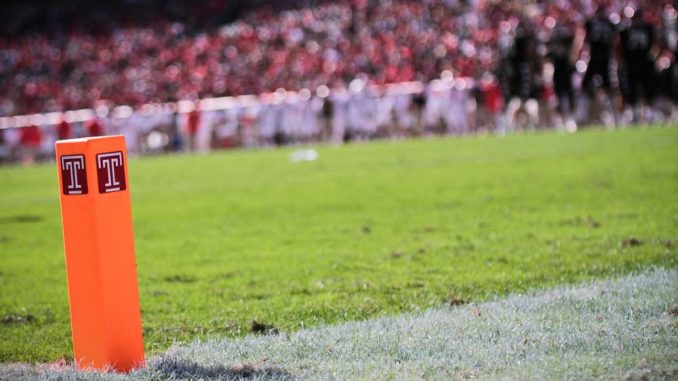
Not all college recruiting is created equal.
Temple’s move to the Big East Conference – and now the American Athletic Conference – was speculated to bolster a recruit’s interest in coming to Temple in most, if not all, sports. But for non-revenue sports, that isn’t necessarily the case.
“I think that’s a little bit of a misconception that people were jumping up and down and were now all of a sudden ready to come to Temple because of that move [to the Big East],” baseball coach Ryan Wheeler said. “I think it intrigued people and it certainly added to what we had to offer, but it wasn’t like all of a sudden a hundred new people were beating down my door trying to come to Temple.”
Temple’s initial transition to a power conference that contained the likes of Louisville, Georgetown and Notre Dame – all of which have strong programs across the board – was assumed to peak interest from possible recruits in most Temple sports. But now that the original Big East has folded, it’s hard to tell what kind of a draw The American will be to prospective student-athletes.
However, several coaches said that The American brand isn’t the be-all, end-all of their recruiting efforts.
“Recruiting wise, it really didn’t make that big of a change,” volleyball coach Bakeer Ganes said. “We’re recruiting those which are interested in [American Coastal Conference] schools, Big East schools and [The American] schools, so ever since I came to Temple we went after people who basically get recruited by BCS conferences.”
“We’ve been able to get in with some kids that we couldn’t get in with when we were in the [Atlantic 10 Conference],” softball coach Joe DiPietro said. “No one really knows the American Athletic Conference yet, so we’re really going to have to sell [the conference] with the schools that are in it.”
Lacrosse and field hockey will remain Big East affiliates because there aren’t enough teams for each conference to host the sport. When trying to recruit players to a team making a conference move, lacrosse coach Bonnie Rosen said it’s not only potential recruits that need convincing, but their parents, too.
“We hear dads say, ‘Oh, you’re going to the Big East?’ or, ‘Oh, you’re going to [The American],’” Rosen said. “A lot of the daughters, the recruits, they want to know, can they make a difference? Are we going to win? What kind of coaches are we? What kind of team do we have?”
With no precedent of competition in the newly-formed conference to draw from, there’s been questions as to whether Temple can reel in the caliber of players it may take to compete in The American.
Ganes said while he looks for a “certain type of player,” the height and athleticism of players that will make up The American is different from A-10 volleyball and something he’ll have to account for.
DiPietro said competition in The American will get him into different recruiting regions, which Ganes reiterated.
“Texas is a hotbed,” Ganes said. “I used to recruit from Texas when I was [an assistant] at West Virginia. I haven’t done that here at Temple so much. But the addition of SMU, Houston and those teams, we’re going to be able to recruit more from Texas just because we’re going to be down there at least once a year.”
Wheeler and tennis coach Steve Mauro admitted it may take more than one recruiting class to transform their programs into legitimate threats.
“I think we need to improve all the way around on the field in order to compete,” Wheeler said. “It’s going to take a little time for us to get the players I think we need in order to compete for a championship.”
“I think next year, once we’re in the conference, it’ll actually help recruiting,” Mauro said. “It’ll be a higher level of competition and hopefully I can bring in a person that wants to play that level of competition.”
Whether or not the Big East is more highly regarded than The American is a moot point. But with the Big East, players and coaches at least knew what they were getting into.
“I think once the Big East fell apart then it was sort of a state of confusion with everybody, including myself,” Wheeler said. “You didn’t know what was going to happen. The enthusiasm didn’t drop because they knew something was going to happen, but they didn’t know what. So they didn’t know whether to be excited or scared.”
Men’s soccer coach Dave MacWilliams said playing in the highest-level conference possible is what “a lot of kids look for.” He said in time The American can build the same reputation the Big East has, and top recruits will be more intrigued as a result.
“I think the Big East name carries tradition, whereas the American Athletic Conference we’re going to have to build a reputation and a tradition,” MacWilliams said.
It’s unclear how well Temple will transition into a conference that poses new recruiting challenges, and just how much of an impact The American name will help to draw top talent.
“It kept us in more conversation with [the type of] players that we were already getting,” Wheeler said of the original Big East move. “But it has not changed [the type of players] that were coming to us before.”
Tyler Sablich and Jake Adams can be reached at sports@temple-news.com.



Be the first to comment